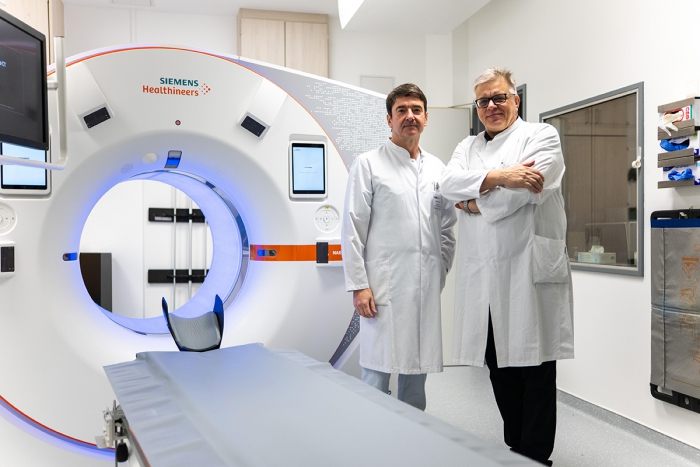NEWS
New quantum-counting CT opens up new possibilities for cancer treatment at the Research Campus STIMULATE
An exciting new research project is planned at the Research Campus STIMULATE in Magdeburg: With a state-of-the-art quantum-counting computer tomograph (photoncounting CT), which was recently put into operation at Magdeburg University Hospital, the team led by Prof Dr Maciej Pech and PD Dr Oliver Großer aims to further improve image-guided cancer treatment.
Dr Großer heads the ‘Interventional Computed Tomography (iCT)’ research group at the Research Campus. Together with his team, he is researching how to better detect whether the tumour has been completely destroyed during the treatment of tumours using heat (known as ablation) - directly during the procedure with the help of CT. Until now, there has been no reliable method for this.
The new CT uses an innovative technology that can visualise more details with less radiation exposure. In future, this should make it possible to precisely visualise the destroyed tumour region (the so-called necrosis zone) - a major step for treatment safety.
The aim of the research project is to use the new CT:
- to visualise the temperature distribution in the body during treatment,
- thus better recording the size of the destroyed tissue region,
- and at the same time to keep the radiation exposure for patients and the surgical team as low as possible.
The new photoncounting CT from Siemens Healthineers offers the best conditions for this: It delivers particularly high-resolution images, is more comfortable for patients and is technically state-of-the-art. With this technology, the Research Campus STIMULATE is strengthening its role as an innovation driver for medical technology - and helping to sustainably improve treatment options for patients.
Photo: (from left) Prof Maciej Pech and Dr Oliver Großer at the newly installed CT scanner from Siemens Healthineers at the University Clinic for Radiology and Nuclear Medicine Magdeburg. Photographer: Emanuel Oropesa Benitez/UMMD
Foto: (v. l.) Prof. Dr. med. Maciej Pech und Privatdozent Dr. rer. nat. Oliver Großer am neu installierten CT der Firma Siemens Healthineers in der Universitätsklinik für Radiologie und Nuklearmedizin Magdeburg. Fotograf: Emanuel Oropesa Benitez/UMMD
Neuer quantenzählender CT eröffnet neue Möglichkeiten für die Krebsbehandlung am Forschungscampus STIMULATE
Am Forschungscampus STIMULATE in Magdeburg ist ein spannendes neues Forschungsprojekt geplant: Mit einem hochmodernen quantenzählenden Computertomographen (Photoncounting-CT), der kürzlich an der Universitätsmedizin Magdeburg in Betrieb genommen wurde, will das Team um Prof. Dr. Maciej Pech und PD Dr. Oliver Großer die bildgestützte Krebsbehandlung weiter verbessern.
PD Dr. Großer leitet die Forschungsgruppe „interventionelle Computertomographie (iCT)“ am Forschungscampus. Gemeinsam mit seinem Team erforscht er, wie man bei der Behandlung von Tumoren durch Hitze (sogenannte Ablation) besser erkennen kann, ob der Tumor vollständig zerstört wurde – direkt während des Eingriffs mithilfe von CT. Bisher fehlt hierfür eine zuverlässige Methode.
Der neue CT nutzt eine innovative Technologie, die mehr Details bei geringerer Strahlenbelastung sichtbar machen kann. Damit soll es zukünftig möglich werden, die zerstörte Tumorregion (die sogenannte Nekrosezone) präzise darzustellen – ein großer Schritt für die Behandlungssicherheit.
Ziel des Forschungsprojekts ist es, mit Hilfe des neuen CTs:
- die Temperaturverteilung im Körper während der Behandlung sichtbar zu machen,
- so die Größe der zerstörten Geweberegion besser zu erfassen,
- und gleichzeitig die Strahlenbelastung für Patientinnen und Patienten und das OP-Team möglichst gering zu halten.
Der neue Photoncounting-CT von Siemens Healthineers bietet dafür die besten Voraussetzungen: Er liefert besonders hochauflösende Bilder, ist komfortabler für Patientinnen und Patienten und technisch auf dem neuesten Stand. Mit dieser Technologie stärkt der Forschungscampus STIMULATE seine Rolle als Innovationsmotor für die Medizintechnik – und trägt dazu bei, die Behandlungsmöglichkeiten für Betroffene nachhaltig zu verbessern.
